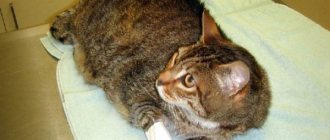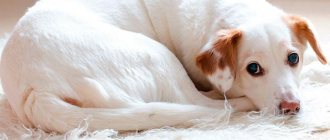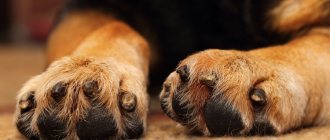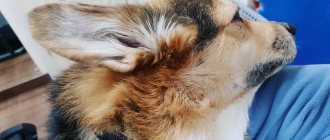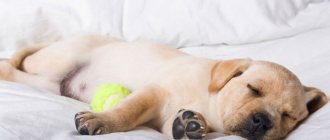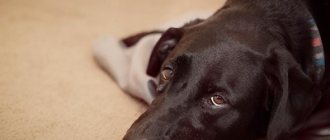Dogs are very active animals, and quite often suffer from various types of injuries and mechanical damage. This usually leads to pain in the hind and forelimbs, because they are at greatest risk. Usually, such problems do not frighten pet owners too much, because it is not for nothing that there is a proverb “heals like a dog.” However, while there is some truth to this, most owners are unaware of the wide range of causes that can cause pain when walking and how difficult some of them can be to treat. That is why, if a dog has a sore paw, you should carefully familiarize yourself with all possible factors that can provoke this symptom and seek qualified help from a veterinarian.
Possible reasons why a dog has a sore paw
Contrary to popular belief, there are many causes of pain in the limbs of dogs, and they are very diverse. Their list includes various diseases, which, in turn, are caused by certain factors. Dog owners concerned about their pet's paws should take a closer look to better understand the situation and possibly avoid it.
So, the list of factors and diseases that can cause pain in a dog’s paws includes:
- Inflammatory processes in the finger area. Most often they are caused by exactly the same reasons as ordinary bruises, mechanical damage to the skin and inflammation of the soft part of the foot. Most often, this kind of process progresses in animals, one of the features of which is an elongated fetter or noticeably spaced front and rear legs (the so-called open limbs). Also, a similar problem can occur in dogs that do not have a natural predisposition to this. The catalyzing factor in such cases is long walks on hard and uneven surfaces, paved sidewalks, as well as standing on the ground for a long time in cold or rainy weather.
- Aseptic inflammation, usually progressing between the dog's toes, can also cause severe pain. However, if no infectious agents penetrate the body, this problem goes away quickly and by itself. However, otherwise, the animal may develop purulent processes, ulcerative wounds or eczema. If this type of inflammation has progressed too severely, the veterinarian will usually use methods used to eliminate inflammation throughout the body (prescribe anti-inflammatory drugs). If a dog actively licks the interdigital area, animal owners should treat this area of the body with aloe. Since the dog needs to walk in any case, the doctor applies a protective bandage to the affected area.
- Ingrown claws. This problem most often occurs in toy breeds of dogs, as well as in animals that move little. They can grow so-called “spur claws”, which, as they grow, bend inward and grow into the paw pads, which, in turn, causes severe inflammation, and subsequently suppuration of the pet’s paw. If your dog's paw hurts, it is worth checking it for the presence of ingrown claws, and if any are found, take the animal to an appointment with a veterinarian, who will eliminate the ingrown nails using surgical forceps.
- Cracks or broken claws. Typically, such problems arise after mechanical damage to the limbs, which was not noticed in time and provoked suppuration and falling off of the claws. This can happen if the animal gets caught on an object. As a rule, in such cases the dog begins to noticeably limp, and touching the paw causes pain. To avoid complete loss of claws and improve the general condition of the animal, the paw must be thoroughly washed, kept in a special softening bath, treated with antiseptics, then dried with cotton wool or bandages. Next, the limb is sprinkled with antimicrobial powder, and a protective bandage is applied. If the nail does not break off, but is only cracked, you can smear it with regular or hypoxic resin. This can help preserve the animal's claws.
- Ulnar hygroma. This disease is characterized by the accumulation of fluid in the elbow joint. The disease most often occurs in large dogs, such as Great Danes or large greyhounds. Their structure is such that the elbow often rests on the surface, which means that the mucous bursa of the elbow is often subjected to pressure and is gradually injured, resulting in a significant increase in size and accumulation of serous fluid (if the disease has become chronic). In some cases, the fluid becomes hemorrhagic or serofibrinous. If the mucous bursa is inflamed, it becomes visible and reaches the size of an egg. But even in this case, it does not provoke lameness. Treatment of ulnar hygroma involves removing the swelling with a syringe. Next, special astringent solutions are injected into the cavity (iodine solution can be used for the procedure). Subsequently, the inflamed area is treated daily with alcohol iodine tincture. If the dog has a relapse, the treatment is repeated exactly. If therapy does not produce any results, doctors recommend a surgical solution to the problem.
- Inflammation of the corolla, also known as claw fever. This name of the disease speaks for itself - claw ulcer is a nail ulcer that usually occurs as a result of wounds, injuries or severe bruises. There is also a possibility that ulceration may appear after the spread of inflammatory processes from adjacent areas of the paws directly to the claw rim. Reaching a severe stage, this disease leads to purulent inflammation and most often provokes absolute rejection of the nail plate. The main symptoms of the disease are lameness, the appearance of swelling and swelling, severe pain at the site of inflammation, as well as a local increase in temperature. The skin around the nail plates gradually begins to turn red, and in severe cases even acquires a purple tint. The claws themselves lose their shine, begin to wobble and eventually disappear completely. Treatment of this disease involves procedures such as taking warm disinfectant baths and applying special antiseptic dressings. If the disease has progressed significantly, it is possible to remove the animal’s claws and even phalanges.
- Damage to paw crumbs. Most often, various kinds of bruises, wounds and bruises of the soft part of the foot in dogs occur in representatives of working and hunting breeds, since these animals move very often, often in unfavorable weather conditions. Symptoms of this type of injury may include slight lameness, fear, and increased caution in the dog when walking. If you feel the crumbs, the dog begins to whine slightly, since bruises always cause severe pain, moreover, the affected area is always a little warmer than the healthy one. Even at home, after a clinical examination, animal owners can find wounds or abrasions. In addition, there is a possibility of burns to the crumbs of the paws. If your dog's paw hurts, but it has not been in contact with fire, think about whether you bathed your pet in hot water, or whether alkali or household acid may have come into contact with the animal's skin. Treatment of bruises, wounds and burns of the flesh includes giving the dog complete rest, removing any foreign objects from the damaged area, cleaning and treating the wound, and in some cases, surgical treatment.
- Joint dysplasia. It most often occurs in puppies. This disease is hereditary and cannot be cured. Gradually, the dog begins to limp heavily, loses the ability to navigate in space and may stop walking altogether. Treatment is mainly symptomatic and is mainly aimed not at recovery, but at prolonging the life of the pet and alleviating its general condition.
- Joint diseases. If a dog's paw hurts, it is worth checking the animal for the presence of diseases such as arthritis, discospondylitis, arthrosis or osteochondrosis. Most often, the above diseases affect the hind limbs. At first, the main symptom of these diseases is lameness. As they progress, they can lead to paw failure and paralysis. Treatment of joint diseases is aimed at prolonging the activity of the animal. In severe cases, treatment is completely useless.
Causes
Dogs are active animals that often injure their joints. In addition to the obvious causes of the disease, there is lameness and reluctance to move.
The disease is typical for service dogs exposed to significant overload, as well as older dogs. The dog handler needs to know what to do in the current situation.
We will talk about the causes of joint diseases, methods of treatment and prevention.
Classification
The following types of damage to bone joints are distinguished:
- Injuries.
- Arthritis.
- Arthrosis.
- Synovitis.
Joint diseases
Injuries
Incised wounds are covered with scab and heal well if the conditionally pathogenic microflora does not penetrate into the joint. The animal needs rest. If the defect is extensive, stitches are applied. Protect the wound from secondary infection. When suppuration develops, antibiotic therapy is used locally, in the form of powders.
Puncture wounds are more difficult to treat. Their consequence is purulent arthritis if the pathogenic microflora enters anaerobic conditions.
Sprains
Distortion (stretching) occurs during sudden jumps, pinching, or being hit by a car. The following symptoms appear the next day:
- lameness;
- soreness;
- the joint is swollen, painful;
- the dog does not lean on its paw, holds it in a half-bent position;
Treatment: a tight bandage is applied and hydrocortisone is injected intramuscularly.
Lameness
Dislocations
The following types of dislocations are distinguished:
- complete, bones completely lose contact;
- subluxation, contact preserved;
- simple, the skin is not damaged;
- open, joint bones exposed;
- congenital, affects mainly puppies;
- familiar.
The pathology is characterized by limited and painful movements. Treatment consists of reduction with local or systemic anesthesia. A bandage is applied that restricts movement for 10–14 days.
DETAILS: Novoslobodskaya Family Clinic - Treatment of Joints
Arthritis
The inflammatory process occurs mainly in old animals. The disease affects massive dogs and spares small dogs. The interosseous joints become painful, and the dog is afraid to move.
The following causes of joint inflammation are identified:
- Functional overload.
- Obesity.
- Genetic predisposition.
The following types of arthritis are distinguished:
- purulent - occurs if the infection gets inside the joint capsule;
- rheumatoid – an autoimmune pathology in which the body perceives its own connective tissue cells as pathogens;
- deforming, is a consequence of constant microtraumas. The bones are deformed, the animal lame;
- dysplasia is a congenital disease of the hip joints. Corrected surgically, the dog is excluded from breeding.
Symptoms
The inflammatory process in the joint causes the following changes in the pet’s behavior:
- limitation of mobility. The dog sleeps a lot;
- the joint swells, becomes painful, hot to the touch;
- lameness, walking with a straight limb;
- rapid weight gain due to adynamia;
- the animal reacts to weather changes.
Treatment
The therapeutic strategy is aimed at relieving pain and restoring cartilage tissue. They use medication or surgery, diet, and physical therapy.
Types of joints
Arthrosis
Arthrosis is the result of long-term permanent dystrophic changes in which the interosseous lining is destroyed. The following stages of arthrosis are distinguished:
- Diagnosed only by x-ray.
- The dog often changes its supporting paw. A crunching sound is heard in the joint. Lameness develops, which manifests itself during active movement.
- The joint is deformed. The paw moves to the side, pain is felt.
The disease is incurable. Surgical intervention is indicated for puppies. The animal will feel satisfactory when performing restrictive measures.
Synovitis
Another name is bursitis. Acute synovitis occurs as a result of a bruise. Based on the nature of the exudate, serous or fibrinous inflammation is distinguished. The dog's initial condition is satisfactory. Tumors of a pasty consistency develop over the joint. Local temperatures are rising. When pressed, the dog whines.
Bursitis
With a long course of the disease, the tumor opens, a fistula forms, and purulent inflammation occurs. Treatment of the disease must be entrusted to a specialist, otherwise the dog risks becoming disabled.
Prevention
Situations in which the pet could be injured should be avoided. He needs gentle exercise, and he needs to control his body weight to avoid overloading his joints. It is recommended to use specialized ready-made food with chondroprotectors. This is especially true for large dogs.
Conclusion
Joint diseases in dogs occur due to their nature, tendency to sudden movements and high physical stress. Cartilage wear occurs in older animals. Measures have been developed to combat diseases that allow the pet to provide a satisfactory standard of living while observing restrictions in the field of housing and feeding.
Arthritis in veterinary medicine is not yet a fully studied disease. The disease is often associated with age, and the cause of its development is degenerative changes in the joint. However, some breeds tend to develop arthritis early. First of all, this applies to large breeds: Chow Chows, Dalmatians, etc. Most likely, this is due to genetically determined anatomical features.
What to do if your dog has a sore paw and how to avoid it?
If your pet's paw hurts a lot, but a home inspection reveals no visible injuries, such as splinters or small wounds, you should take your pet to the vet. Pain in the limbs, as a rule, does not require severe treatment, of course, if the necessary measures are taken in time. Even minor damage to the nail plates can lead to very sad consequences, for example, suppuration or even complete loss of the nail plate. Moreover, there is a possibility that pain in the paws is a symptom of serious hereditary diseases that are very difficult to treat.
To avoid such problems in the future, pet owners should properly care for their pets. To do this, you need to carefully examine the dog's paws at least once a week, and if the dog is extremely active and often runs on hard and uneven surfaces, it is better to purchase special boots for it. Nail plates should be trimmed not occasionally, but regularly. It is also necessary to keep your pet's paw pads clean and frequently clean them of dirt and small foreign bodies. If your dog has a lot of hair growing between the toes, it needs to be trimmed frequently.
